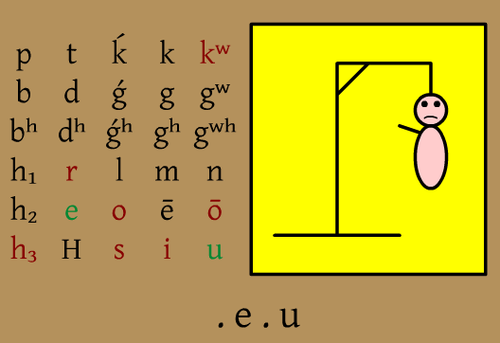Proto-Indo-European Hangman!
AllThingsLinguistic on tumblr just posted something brilliant: an online game of Proto-Indo-European Hangman!
So, language families are groups of languages with a common ancestor, that most old language is known as the proto-language. The word family is often used both to refer to the top-level-grouping and sometimes also lower levels. I prefer using it only for top-level, but hey that's me. There's been roughly 27 proto-languages reconstructed at that top-most level. It should come as no surprise that Indo-European is one that we know the most about.
The study of languages history and reconstruction is within the field of Historial Linguistics. It's an area where the debates can get unusually intense, for example like when Burushaski was suggested as being IE and not an isolate. (Isolate = language with no known living relatives.)
As an illustration of the field: Ethnologue counts 130 families, Campbell (2007) 350, Nichols (1992) approx 300, WALS 212 and finally Glottolog 244. In the case of Ethnologue and Glottolog I've tried to normalize by excluding sign languages, isolates, artificial, contact languages and types Ethnologue calls "unclassifiable". Isolates are also excluded in Campbell's count.
Let's get back to Hangman!
From AllThingsLinguistic:
__________________________________
This is a game of hangman where all of the words are reconstructed Proto-Indo-European words. I can’t claim it’s easy (in fact, it’s really quite hard), but it’s definitely an interesting way of learning more about PIE.

After a few rounds, you may get a better sense of which sounds are more versus less common in PIE, and after a few more, you may start noticing repeats, as it’s only drawing on a list of 18 words. Of course, you could also cheat and look up a list of Proto-Indo-European words to help.
__________________________________
Fun, eigh?
Nichols, Johanna. 1992. Linguistic diversity in space and time. Chicago: University of Chicago Press. 374pp.
So, language families are groups of languages with a common ancestor, that most old language is known as the proto-language. The word family is often used both to refer to the top-level-grouping and sometimes also lower levels. I prefer using it only for top-level, but hey that's me. There's been roughly 27 proto-languages reconstructed at that top-most level. It should come as no surprise that Indo-European is one that we know the most about.
The study of languages history and reconstruction is within the field of Historial Linguistics. It's an area where the debates can get unusually intense, for example like when Burushaski was suggested as being IE and not an isolate. (Isolate = language with no known living relatives.)
As an illustration of the field: Ethnologue counts 130 families, Campbell (2007) 350, Nichols (1992) approx 300, WALS 212 and finally Glottolog 244. In the case of Ethnologue and Glottolog I've tried to normalize by excluding sign languages, isolates, artificial, contact languages and types Ethnologue calls "unclassifiable". Isolates are also excluded in Campbell's count.
Let's get back to Hangman!
From AllThingsLinguistic:
__________________________________
This is a game of hangman where all of the words are reconstructed Proto-Indo-European words. I can’t claim it’s easy (in fact, it’s really quite hard), but it’s definitely an interesting way of learning more about PIE.

After a few rounds, you may get a better sense of which sounds are more versus less common in PIE, and after a few more, you may start noticing repeats, as it’s only drawing on a list of 18 words. Of course, you could also cheat and look up a list of Proto-Indo-European words to help.
__________________________________
Fun, eigh?
References
Campbell 2007. How Many Language Families are there in the World, Really? Paper presented at the International Conference on Historical Linguistics, Aug 6-12, 2007, University of Quebec, Montreal.
Campbell 2007. How Many Language Families are there in the World, Really? Paper presented at the International Conference on Historical Linguistics, Aug 6-12, 2007, University of Quebec, Montreal.
Nichols, Johanna. 1992. Linguistic diversity in space and time. Chicago: University of Chicago Press. 374pp.



Comments
Post a Comment